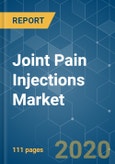The rise in the prevalence of arthritis and musculoskeletal disorders is driving the demand for joint pain injections usage, especially among the population aged 65 years or older as they are more prone to joint pains.
According to the Arthritis Research UK report named, “The State of Musculoskeletal Health 2018”, it is estimated that 17.8 million people live with a musculoskeletal condition in the UK. Which is around 28.9% of the total population. As oral medications do not relieve joint pains and most of the patients are not interested in approaching surgeries joint pain injections act as the most desirable procedures.
However, lack of awareness regarding these injections and the high cost of the products might hamper the growth of the market.
Key Market Trends
Steroid joint Injection Segment Holds a Significant Market Share
A steroid joint pain injection is a minimally invasive procedure that can relieve the pain caused by the joint inflammation temporarily. Steroid joint pain injection comprises both corticosteroid and an anesthetic numbing agent such as lidocaine or bupivacaine. The drugs are delivered to the painful joint, inside the joint capsule.
Steroid injections thus reduces the inflammation and are effective when administered into the painful area directly. The benefits can last for several months. The market players are extensively focusing on the development of novel products with many advantages and also launching products frequently.
North America is Expected to Hold the Largest Market Share in the Joint Pain Injections Market
North America is expected to dominate the market due to the high prevalence of musculoskeletal disorders that causes joint pains. Increasing awareness of the Non-invasive orthopedic treatments, continuous innovation in the implant technologies, and advanced healthcare facilities.
According to the Centers for Disease Control and Prevention (CDC), chronic pain caused by arthritis affects millions of people in the United States every year. About one in four adults with arthritis, 15 million people report experiencing severe joint pain related to arthritis. A high adoption rate of advanced technologies is also the factors driving the growth of the market in this region. Additionally, major market players are making huge investments in research activities, which will eventually drive the market in North America.
Competitive Landscape
The global joint pain injections market is a moderately fragmented market. Market players focus on continuous product development and offering joint pain injections at competitive prices especially in developing countries.
Key developments in the market include: In February 2017, Zimmer Biomet received U.S.FDA approval for its Gel-One Hyaluronate a hyaluronic acid injection for 26 weeks in patients for the treatments knee osteoarthritis and In May 2018, Teva Pharmaceuticals USA, Inc. received U.S.FDA approval for SYNOJOYNT as a pain reliever in patients with osteoarthritis in the knee.
Reasons to Purchase this report:
This product will be delivered within 2 business days.
According to the Arthritis Research UK report named, “The State of Musculoskeletal Health 2018”, it is estimated that 17.8 million people live with a musculoskeletal condition in the UK. Which is around 28.9% of the total population. As oral medications do not relieve joint pains and most of the patients are not interested in approaching surgeries joint pain injections act as the most desirable procedures.
However, lack of awareness regarding these injections and the high cost of the products might hamper the growth of the market.
Key Market Trends
Steroid joint Injection Segment Holds a Significant Market Share
A steroid joint pain injection is a minimally invasive procedure that can relieve the pain caused by the joint inflammation temporarily. Steroid joint pain injection comprises both corticosteroid and an anesthetic numbing agent such as lidocaine or bupivacaine. The drugs are delivered to the painful joint, inside the joint capsule.
Steroid injections thus reduces the inflammation and are effective when administered into the painful area directly. The benefits can last for several months. The market players are extensively focusing on the development of novel products with many advantages and also launching products frequently.
North America is Expected to Hold the Largest Market Share in the Joint Pain Injections Market
North America is expected to dominate the market due to the high prevalence of musculoskeletal disorders that causes joint pains. Increasing awareness of the Non-invasive orthopedic treatments, continuous innovation in the implant technologies, and advanced healthcare facilities.
According to the Centers for Disease Control and Prevention (CDC), chronic pain caused by arthritis affects millions of people in the United States every year. About one in four adults with arthritis, 15 million people report experiencing severe joint pain related to arthritis. A high adoption rate of advanced technologies is also the factors driving the growth of the market in this region. Additionally, major market players are making huge investments in research activities, which will eventually drive the market in North America.
Competitive Landscape
The global joint pain injections market is a moderately fragmented market. Market players focus on continuous product development and offering joint pain injections at competitive prices especially in developing countries.
Key developments in the market include: In February 2017, Zimmer Biomet received U.S.FDA approval for its Gel-One Hyaluronate a hyaluronic acid injection for 26 weeks in patients for the treatments knee osteoarthritis and In May 2018, Teva Pharmaceuticals USA, Inc. received U.S.FDA approval for SYNOJOYNT as a pain reliever in patients with osteoarthritis in the knee.
Reasons to Purchase this report:
- The market estimate (ME) sheet in Excel format
- 3 months of analyst support
This product will be delivered within 2 business days.
Table of Contents
1 INTRODUCTION
4 MARKET DYNAMICS
5 MARKET SEGMENTATION
6 COMPETITIVE LANDSCAPE
Companies Mentioned (Partial List)
A selection of companies mentioned in this report includes, but is not limited to:
- Anika Therapeutics, Inc.
- Bioventus.
- Ferring Pharmaceuticals Inc.
- Sanofi S.A.
- Pfizer Inc.
- Eli Lilly and Company
- Flexion Therapeutics, Inc.
- Teva Pharmaceuticals
- Zimmer Biomet
Methodology

LOADING...








